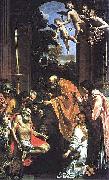Wholesale Oil Painting Reproductions No Minimum and Door to Door! |
|||||||||||
|
|
|||||||||||

|
|||||||||||
|
|
|
||||||||
All Domenichino Oil Paintings |
||||||||
|
|
||||||||
|
|
||||||||
|
Artist Introduction: 1581-1641
Italian
Domenichino Locations
Italian painter and draughtsman. On the basis of his frescoes and altarpieces he became established as the most influential exponent of the 17th-century classical style. Through his critical analysis of the art of Raphael and Annibale Carracci he was influential in the creation of a modern canon of the ancients; and he was perhaps the most complete example of a 17th-century artist struggling to reconcile tradition with the demand for spectacle. |
||||||||
|
|
||||||||
|
Last Communion of St. Jerome, Painting ID:: 58692 |
Last Communion of St. Jerome, 1614, Pinacoteca Vaticana |
|||||||
Height Width |
INS/CM Quality |
|||||||
|
X |
| |||||||
|
|
||||||||
|
Prev Next
|
||||||||
|
|
||||||||
|
Related Paintings to Domenico Zampieri :. |
||||||||
|
|
||||||||
|
CONTACT US |

